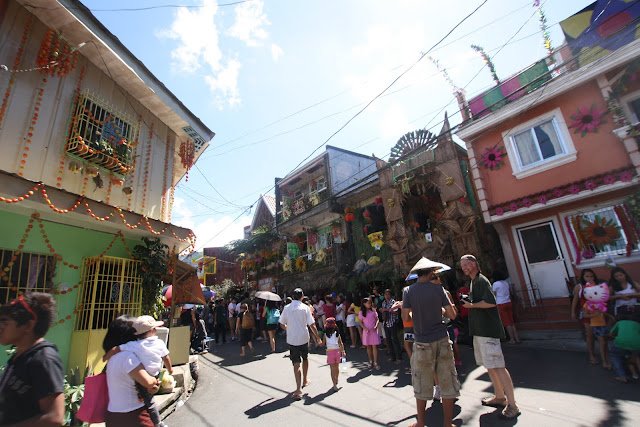Advertisement
Published: March 7th 2012
A display of various arresting colours designed like chandeliers made of leaf like materials called kipping decorated most of the façade of the houses. Curiosity sank in when I saw throng of people walking on one direction. Even the day was filthy hot with no available shade of comfort we joined the throng and found ourselves bathed with various arresting colors.
<table class="tr-caption-container" style="margin-left: auto; margin-right: auto; text-align: center;" cellspacing="0" cellpadding="0" align="center"><tbody><tr><td style="text-align: center;">

</td></tr><tr><td class="tr-caption" style="text-align: center;">
Lucban celebrates the Pahiyas Festival every May 15 in honor of the patron saint of farmers,
St. Isidore. This festival showcases a street of houses which are adorned with fruits, vegetables, agricultural products, handicrafts and
kiping, a rice-made decoration, which afterwards can be eaten grilled or fried. The houses are judged and the best one is proclaimed the winner. (wikipedia)</td></tr></tbody></table>
<table class="tr-caption-container" style="margin-left: auto; margin-right: auto; text-align: center;" cellspacing="0" cellpadding="0" align="center"><tbody><tr><td style="text-align: center;">

</td></tr><tr><td class="tr-caption" style="text-align: center;">
Called
longganisa in the Philippines, the sausages are flavoured with indigenous spices, with each region having its own specialty. Among others, Lucban is known for its garlicky longanizas (derecado)</td></tr></tbody></table>
<table class="tr-caption-container" style="margin-left: auto; margin-right: auto; text-align: center;" cellspacing="0" cellpadding="0" align="center"><tbody><tr><td style="text-align: center;">

</td></tr><tr><td class="tr-caption" style="text-align: center;">
The houses are judged and the best one is proclaimed the winner.
</td></tr></tbody></table>
<table class="tr-caption-container" style="margin-left: auto; margin-right: auto; text-align: center;" cellspacing="0" cellpadding="0" align="center"><tbody><tr><td style="text-align: center;">

</td></tr><tr><td class="tr-caption" style="text-align: center;">
Every year, tourists roam the municipality to witness the decoration of houses.</td></tr></tbody></table>
<table class="tr-caption-container" style="margin-left: auto; margin-right: auto; text-align: center;" cellspacing="0" cellpadding="0" align="center"><tbody><tr><td style="text-align: center;">

</td></tr><tr><td class="tr-caption" style="text-align: center;">
This garden landed this house to third place. </td></tr></tbody></table>
<table class="tr-caption-container" style="margin-left: auto; margin-right: auto; text-align: center;" cellspacing="0" cellpadding="0"><tbody><tr><td style="text-align: center;">

</td></tr><tr><td class="tr-caption" style="text-align: center;">
Kiping, a rice-made decoration, which afterwards can be eaten grilled or fried. </td></tr></tbody></table><table class="tr-caption-container" style="float: left; margin-right: 1em; text-align: left;" cellspacing="0" cellpadding="0"><tbody><tr><td style="text-align: center;">

</td></tr><tr><td class="tr-caption" style="text-align: center;">
Longganisa lucban is a garlicky slightly sour sausage that is quite similar to chorizo de bilbao, the famous garlic sausage from Spain.</td></tr></tbody></table>
<table class="tr-caption-container" style="margin-left: auto; margin-right: auto; text-align: center;" cellspacing="0" cellpadding="0" align="center"><tbody><tr><td style="text-align: center;">

</td></tr><tr><td class="tr-caption" style="text-align: center;">
Lucban is starting to get noticed because of their impressive hats. Visit Lucban and feel like Queen Elizabeth - no rush!</td></tr></tbody></table>
<table class="tr-caption-container" style="margin-left: auto; margin-right: auto; text-align: center;" cellspacing="0" cellpadding="0" align="center"><tbody><tr><td style="text-align: center;">

</td></tr><tr><td class="tr-caption" style="text-align: center;">
Speaking about the colorful houses, the usual decoration used of the Lucbanins is the brightly colored rice wafer, called kiping. Besides San Isidro Labrador – the patron of the farmers, Lucban Pahiyas is not Lucban Pahiyas without kiping. (wowquezon)</td></tr></tbody></table>
<table class="tr-caption-container" style="margin-left: auto; margin-right: auto; text-align: center;" cellspacing="0" cellpadding="0" align="center"><tbody><tr><td style="text-align: center;">

</td></tr><tr><td class="tr-caption" style="text-align: center;">
Making kiping is a time-consuming process. Its name came from “Kipi” or “Kinipi” which describes how laborious the process of making one. It undergoes many steps before it can be used as a decoration for the festival. (w0wquezon)</td></tr></tbody></table>
<table class="tr-caption-container" style="margin-left: auto; margin-right: auto; text-align: center;" cellspacing="0" cellpadding="0" align="center"><tbody><tr><td style="text-align: center;">

</td></tr><tr><td class="tr-caption" style="text-align: center;">
A replica of the Lucban Church made of coconut husks. </td></tr></tbody></table>
<table class="tr-caption-container" style="float: left; margin-right: 1em; text-align: left;" cellspacing="0" cellpadding="0"><tbody><tr><td style="text-align: center;">

</td></tr><tr><td class="tr-caption" style="text-align: center;">
Isidore was born to very poor parents in Madrid, about the year 1070. He was in the service of the wealthy Madrid landowner Juan de Vargas on a farm in the vicinity of Madrid. Juan de Vargas would later make him
bailiff of his entire estate of Lower Caramanca</td></tr></tbody></table>
<table class="tr-caption-container" style="margin-left: auto; margin-right: auto; text-align: center;" cellspacing="0" cellpadding="0" align="center"><tbody><tr><td style="text-align: center;">

</td></tr><tr><td class="tr-caption" style="text-align: center;">
The townsfolk trot out their beloved <strong class="selflink">gigantes or giants. Measuring about 14 feet tall, the giants come in pairs, the
mag-asawa or couple, a giant man dressed in the peasant's camisa chino or undershirt, and his wife clad in the native
patadyong and
kimona, a loose skirt topped with a flimsy blouse. Made from papier mache, the giants are borne on shoulders by those who have made it, a panata is made in return for a favor received. </td></tr></tbody></table>
<table class="tr-caption-container" style="margin-left: auto; margin-right: auto; text-align: center;" cellspacing="0" cellpadding="0" align="center"><tbody><tr><td style="text-align: center;">

</td></tr><tr><td class="tr-caption" style="text-align: center;">
Buddy's - Dito parang laging Fiesta!</td></tr></tbody></table>
<table class="tr-caption-container" style="margin-left: auto; margin-right: auto; text-align: center;" cellspacing="0" cellpadding="0" align="center"><tbody><tr><td style="text-align: center;">

</td></tr><tr><td class="tr-caption" style="text-align: center;">
This is the Lucban Church in Quezon, which is almost 400 years old. Said the inscription: ” The first church, built in 1595, was ruined in 1629. The second church was constructed between 1630 and 1640, but was seriously damaged by fire in 1733. The present church was completed in 1738 and the convent in 1743.”</td></tr></tbody></table>
<table class="tr-caption-container" style="margin-left: auto; margin-right: auto; text-align: center;" cellspacing="0" cellpadding="0" align="center"><tbody><tr><td style="text-align: center;">

</td></tr><tr><td class="tr-caption" style="text-align: center;">
THANK YOU LUCBAN FOR A COLORFUL AND WONDERFUL PAHIYAS EXPERIENCE.</td></tr></tbody></table>
Advertisement
Tot: 0.088s; Tpl: 0.01s; cc: 5; qc: 41; dbt: 0.033s; 1; m:domysql w:travelblog (10.17.0.13); sld: 1;
; mem: 1.1mb
 </td></tr><tr><td class="tr-caption" style="text-align: center;">
</td></tr><tr><td class="tr-caption" style="text-align: center;">
 </td></tr><tr><td class="tr-caption" style="text-align: center;">
</td></tr><tr><td class="tr-caption" style="text-align: center;">
 </td></tr><tr><td class="tr-caption" style="text-align: center;">
</td></tr><tr><td class="tr-caption" style="text-align: center;">
 </td></tr><tr><td class="tr-caption" style="text-align: center;">
</td></tr><tr><td class="tr-caption" style="text-align: center;">
 </td></tr><tr><td class="tr-caption" style="text-align: center;">
</td></tr><tr><td class="tr-caption" style="text-align: center;">
 </td></tr><tr><td class="tr-caption" style="text-align: center;">
</td></tr><tr><td class="tr-caption" style="text-align: center;">
 </td></tr><tr><td class="tr-caption" style="text-align: center;">
</td></tr><tr><td class="tr-caption" style="text-align: center;">
 </td></tr><tr><td class="tr-caption" style="text-align: center;">
</td></tr><tr><td class="tr-caption" style="text-align: center;">
 </td></tr><tr><td class="tr-caption" style="text-align: center;">
</td></tr><tr><td class="tr-caption" style="text-align: center;">
 </td></tr><tr><td class="tr-caption" style="text-align: center;">
</td></tr><tr><td class="tr-caption" style="text-align: center;">
 </td></tr><tr><td class="tr-caption" style="text-align: center;">
</td></tr><tr><td class="tr-caption" style="text-align: center;">
 </td></tr><tr><td class="tr-caption" style="text-align: center;">
</td></tr><tr><td class="tr-caption" style="text-align: center;">
 </td></tr><tr><td class="tr-caption" style="text-align: center;">
</td></tr><tr><td class="tr-caption" style="text-align: center;">
 </td></tr><tr><td class="tr-caption" style="text-align: center;">
</td></tr><tr><td class="tr-caption" style="text-align: center;">
 </td></tr><tr><td class="tr-caption" style="text-align: center;">
</td></tr><tr><td class="tr-caption" style="text-align: center;">
 </td></tr><tr><td class="tr-caption" style="text-align: center;">
</td></tr><tr><td class="tr-caption" style="text-align: center;">